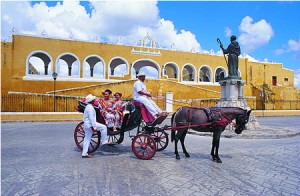 Izamal is a small colonial population in the state of Yucatan. It is named for the Mayan and means “dew of heaven”, it is located just 72 kilometers from Merida. It is known as the “city of three cultures”, since it combines features of its pre-Hispanic past, of the colonial period and modern times, also it has been called the “Yellow City” because most of their buildings are painted in this color. The city has been chosen as a “Magic Town”. In the city of Izamal, as in many towns of the Yucatan, the Mayan language is still spoken by most of its inhabitants.
Izamal is a small colonial population in the state of Yucatan. It is named for the Mayan and means “dew of heaven”, it is located just 72 kilometers from Merida. It is known as the “city of three cultures”, since it combines features of its pre-Hispanic past, of the colonial period and modern times, also it has been called the “Yellow City” because most of their buildings are painted in this color. The city has been chosen as a “Magic Town”. In the city of Izamal, as in many towns of the Yucatan, the Mayan language is still spoken by most of its inhabitants.
Izamal was one of the most important sites of Mayan civilization, a large settlement on the plains of the northern Yucatán Peninsula. The size of its buildings and network of pathways called ‘sacbes’ (white road built in the ancient Maya) are evidence of the religious, political and economic power that the city had over the vast territory of the Mayab. more…
Category: Izamal
|
Tags: City of three Cultures, dew of heaven, Izamal, Kinich Kakmó, Magic Town, Mayab, Mayan, Merida, Pap Hol Chack, Sacbes, San Antonio de Padua, TokHun Pik, Water of Life, Yellow City, Yucatan, Yucatan Peninsula |
Comments off
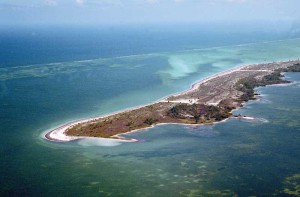 Holbox is a small and beautiful island located in the north of the state of Quintana Roo, its name come from the Mayan and means “black hole”. It has 43 km long, 2 km wide and about 34 km of white sandy beaches with countless shells in the coast. It is attached to the Yucatan Peninsula by a sand bar and several canals that join it to the sea and to the lagoon Yalahau. Holbox belongs to the municipality of Lázaro Cárdenas and is part also part of the biosphere reserve and protected area of Yum Balam which means Lord Jaguar, a reserve of 154,000 km2. more…
Holbox is a small and beautiful island located in the north of the state of Quintana Roo, its name come from the Mayan and means “black hole”. It has 43 km long, 2 km wide and about 34 km of white sandy beaches with countless shells in the coast. It is attached to the Yucatan Peninsula by a sand bar and several canals that join it to the sea and to the lagoon Yalahau. Holbox belongs to the municipality of Lázaro Cárdenas and is part also part of the biosphere reserve and protected area of Yum Balam which means Lord Jaguar, a reserve of 154,000 km2. more…
Category: General, Holbox
|
Tags: Caribbean Sea, Gulf of Mexico, Holbox, lagoon Yalahau, Lázaro Cárdenas, lobster pizza, Lord Jaguar, Port of Chiquilá, Quintana Roo, Yalahau, Yucatan, Yucatan Peninsula, Yum Balam |
Comments off
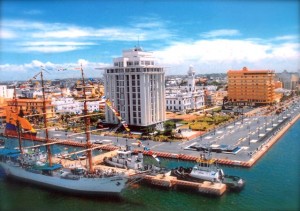 The city of Veracruz is the largest and most important city of the state of Veracruz; it has the largest commercial seaport in Mexico. It is located 90 km from Jalapa and 400 km from Mexico City. Historically, this city is known for being founded by Hernan Cortés, due to it was in the region where the Spanish troops landed to then undertake the conquest of the Aztec Empire. It is also four times heroic, for the courageous struggle of its population against four different foreign invasions. It is known as “The door from Mexico to the World” (La Puerta de Mexico al Mundo), since the port is and has been the largest in the country since its beginnings in the colonial era to the present day and was for 250 years the only port through which goods could enter and leave continental America to Europe. more…
The city of Veracruz is the largest and most important city of the state of Veracruz; it has the largest commercial seaport in Mexico. It is located 90 km from Jalapa and 400 km from Mexico City. Historically, this city is known for being founded by Hernan Cortés, due to it was in the region where the Spanish troops landed to then undertake the conquest of the Aztec Empire. It is also four times heroic, for the courageous struggle of its population against four different foreign invasions. It is known as “The door from Mexico to the World” (La Puerta de Mexico al Mundo), since the port is and has been the largest in the country since its beginnings in the colonial era to the present day and was for 250 years the only port through which goods could enter and leave continental America to Europe. more…
Category: Veracruz
|
Tags: 13 wonders of Mexico, Aztecs, Bastion of Santiago, Carnival of Veracruz, Costa de oro, Danzon, Gran Cafe de la Parroquia, Hernan Cortes, Jalapa, Mocambo, Playon de Hornos, Plaza de la Constitucion, San Juan de Ulua, Veracruz, Veracruz Reef System, Villa del Mar |
Comments off
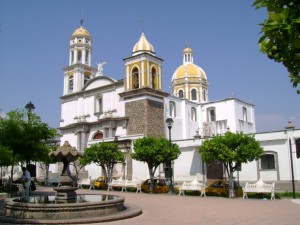 Comala is a small town in the state of Colima, its name comes from the Nahuatl “comalli” which means “place of comal”, (Comal is a type of traditional cookware used mostly to make or to warm tortillas); this destination is also known as “America’s white town” thanks to the fact that most of its white facades are highlighted by its red roofs. This town is famous for the excellent weather, its streets, its cuisine and the people who jealously keeps their traditions. In 1988 it was declared an Area of Historic Monuments and in 2002 was elected to the national program “Magic Towns of Mexico”. It is one of the most famous places of Colima by the legend, folklore and traditions that are mentioned in the novel Pedro Paramo, from the renowned writer Juan Rulfo, borned in Jalisco. The oldest inhabitants of the territory of Comala settled there 3,000 years ago some of the major cultures were the Olmec, Nahuatl, Toltec, Chichimecan and finally the Tarascan at the arrival of the Spanish troops. Many indigenous are still settling in Suchitlan, a town next to Comala. more…
Comala is a small town in the state of Colima, its name comes from the Nahuatl “comalli” which means “place of comal”, (Comal is a type of traditional cookware used mostly to make or to warm tortillas); this destination is also known as “America’s white town” thanks to the fact that most of its white facades are highlighted by its red roofs. This town is famous for the excellent weather, its streets, its cuisine and the people who jealously keeps their traditions. In 1988 it was declared an Area of Historic Monuments and in 2002 was elected to the national program “Magic Towns of Mexico”. It is one of the most famous places of Colima by the legend, folklore and traditions that are mentioned in the novel Pedro Paramo, from the renowned writer Juan Rulfo, borned in Jalisco. The oldest inhabitants of the territory of Comala settled there 3,000 years ago some of the major cultures were the Olmec, Nahuatl, Toltec, Chichimecan and finally the Tarascan at the arrival of the Spanish troops. Many indigenous are still settling in Suchitlan, a town next to Comala. more…
Category: Comala
|
Tags: america's white town, carrizalillo, Colima, colima volcano, Comala, comales, Guadalupe virgin, Jalisco, juan rulfo, juan soriano, magic towns, mezcal, nevado de colima, pedro paramo, portals of comala, st. michael archangel, suchitlan, volcano of fire, wooden masks |
Comments off
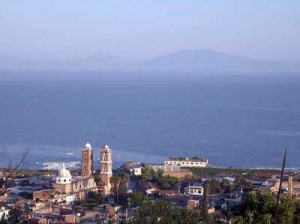 Chapala is the largest of the six Lakeside communities. The region where Lake Chapala is located was called Chimaloacán: “place for the people using shield”. In the ninth century a big migration of Nahuatl origin tribes, from the northwest of the country, gave rise to the major settlements of the central plateau of Mexico; the residents of Chapala belonged to the group of Tanalan from where a warlord named Chapa encouraged groups to form a new population on the shores of the lake. Thus was formed Chapatla or Chapatlán. The word Chapala comes from the Nahuatl and means “place of Grasshoppers on the water”. Due to the characteristics of the area, the main activities were fishing, hunting, trade and agriculture. Over the entire basin was established the first pre-Hispanic communications between Tenochtitlan and northern and western regions. Later this long basin favored the Spanish exploration and conquest. more…
Chapala is the largest of the six Lakeside communities. The region where Lake Chapala is located was called Chimaloacán: “place for the people using shield”. In the ninth century a big migration of Nahuatl origin tribes, from the northwest of the country, gave rise to the major settlements of the central plateau of Mexico; the residents of Chapala belonged to the group of Tanalan from where a warlord named Chapa encouraged groups to form a new population on the shores of the lake. Thus was formed Chapatla or Chapatlán. The word Chapala comes from the Nahuatl and means “place of Grasshoppers on the water”. Due to the characteristics of the area, the main activities were fishing, hunting, trade and agriculture. Over the entire basin was established the first pre-Hispanic communications between Tenochtitlan and northern and western regions. Later this long basin favored the Spanish exploration and conquest. more…
Category: Chapala
|
Tags: Acapulquito, Ajijic, Carnival, Chapa, Chapala, Chapala Lake, Chapatla, Chapatlán, Charreria, charros, Chimaloacán, Church of San Francisco, Cristiania Park, Guadalajara, Isla de los alacranes, Island of the Scorpions, Jalisco, Jocotepec, Malecon, Mexico City, Mezcala, Michoacán, Nahuatl, natural hot spring, natural resorts, natural therapy, Parish, San Francisco de Asis, San Juan Cosala, spas, Tanalan, Tenochtitlan, tianguis |
Comments off
 Izamal is a small colonial population in the state of Yucatan. It is named for the Mayan and means “dew of heaven”, it is located just 72 kilometers from Merida. It is known as the “city of three cultures”, since it combines features of its pre-Hispanic past, of the colonial period and modern times, also it has been called the “Yellow City” because most of their buildings are painted in this color. The city has been chosen as a “Magic Town”. In the city of Izamal, as in many towns of the Yucatan, the Mayan language is still spoken by most of its inhabitants.
Izamal is a small colonial population in the state of Yucatan. It is named for the Mayan and means “dew of heaven”, it is located just 72 kilometers from Merida. It is known as the “city of three cultures”, since it combines features of its pre-Hispanic past, of the colonial period and modern times, also it has been called the “Yellow City” because most of their buildings are painted in this color. The city has been chosen as a “Magic Town”. In the city of Izamal, as in many towns of the Yucatan, the Mayan language is still spoken by most of its inhabitants.



